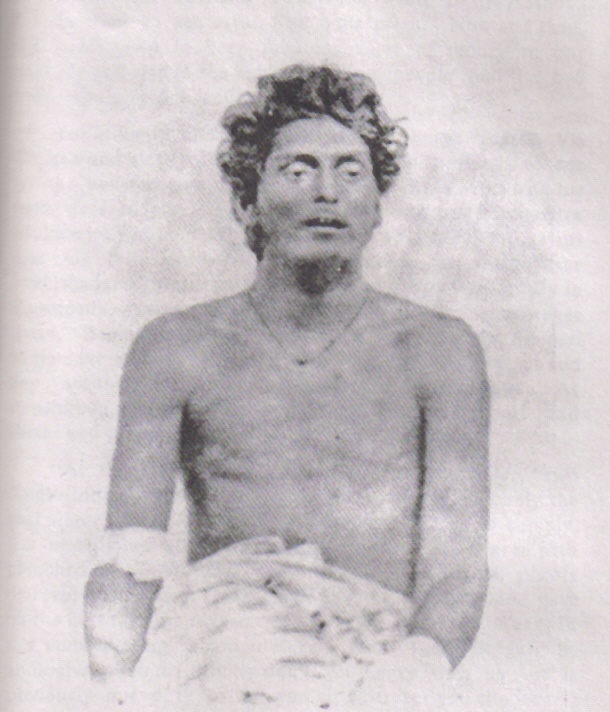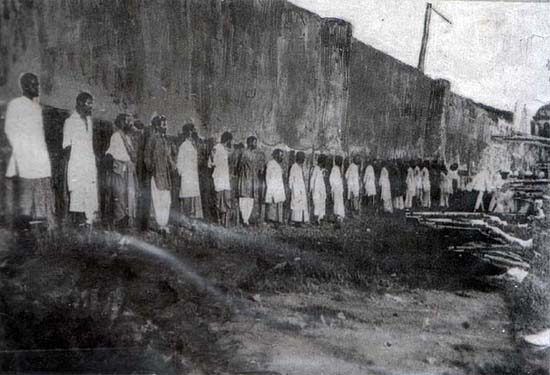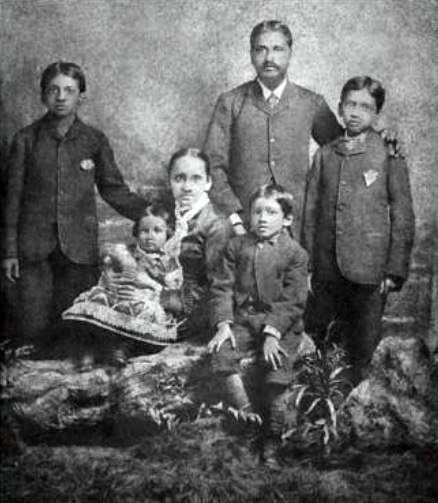|
Anushilan
Anushilan Samiti ( bn, অনুশীলন সমিতি, , bodybuilding society) was an Indian fitness club, which was actually used as an underground society for anti-British revolutionaries. In the first quarter of the 20th century it supported revolutionary violence as the means for ending British rule in India. The organisation arose from a conglomeration of local youth groups and gyms (akhara) in Bengal in 1902. It had two prominent, somewhat independent, arms in East and West Bengal, Dhaka Anushilan Samiti (centred in Dhaka), and the Jugantar group (centred in Calcutta). From its foundation to its dissolution during the 1930s, the Samiti challenged British rule in India by engaging in militant nationalism, including bombings, assassinations, and politically motivated violence. The Samiti collaborated with other revolutionary organisations in India and abroad. It was led by the nationalists Aurobindo Ghosh and his brother Barindra Ghosh, influenced by philosophies li ... [...More Info...] [...Related Items...] OR: [Wikipedia] [Google] [Baidu] |
History Of The Anushilan Samiti
The history of the Anushilan Samiti stretches from its beginning early in the first decade of 1900 to 1930. The ''Samiti'' began in the first decade of the 20th century in Calcutta as conglomeration of local youth groups and gyms. However, its focus was both physical education and proposed moral development of its members. From its inception it sought to promote what it perceived as Indian values and to focus on Indian sports e.g. '' Lathi'' and Sword play. It also encouraged its members to study Indian history as well as those of European liberalism including the French Revolution, Russian Nihilism and Italian unification. Soon after its inception it became a radical organisation that sought to end British Raj in India through revolutionary violence. After World War I, it declined steadily as its members identified closely with leftist ideologies and with the Indian National Congress. It briefly rose to prominence in the late second and third decade, being involved in some notab ... [...More Info...] [...Related Items...] OR: [Wikipedia] [Google] [Baidu] |
Alipore Bomb Case
''Emperor vs Aurobindo Ghosh and others'', colloquially referred to as the Alipore Bomb Case, the Muraripukur conspiracy, or the Manicktolla bomb conspiracy, was a criminal case held in India in 1908. The case saw the trial of a number of Indian nationalists of the Anushilan Samiti in Calcutta, under charges of "Waging war against the Government" of the British Raj. The trial was held at Alipore Sessions Court, Calcutta, between May 1908 and May 1909. The trial followed in the wake of the attempt on the life of Presidency Magistrate Douglas Kingsford in Muzaffarpur by Bengali nationalists Khudiram Bose and Prafulla Chaki in April 1908, which was recognised by the Bengal police as linked to attacks against the Raj in the preceding years, including attempts to derail the train carrying Lieutenant-Governor Sir Andrew Fraser in December 1907. Among the famous accused were Aurobindo Ghosh, his brother Barin Ghosh as well as 38 other Bengali nationalists of the ''Anushilan Samiti''. ... [...More Info...] [...Related Items...] OR: [Wikipedia] [Google] [Baidu] |
Revolutionary Movement For Indian Independence
The Revolutionary movement for Indian Independence was the part of the Indian independence movement comprising the actions of violent underground revolutionary factions. Groups believing in armed revolution against the ruling British fall into this category, as opposed to the generally peaceful civil disobedience movement spearheaded by Mohandas Karamchand Gandhi. The revolutionary groups were mainly concentrated in Bengal, Maharashtra, Bihar, the United Provinces and Punjab. More groups were scattered across India. Beginnings Apart from a few stray incidents, the armed rebellion against the British rulers was not organised before the beginning of the 20th century. The revolutionary philosophies and movement made its presence felt during 1905 partition of Bengal. Arguably, the initial steps to organise the revolutionaries were taken by Aurobindo Ghosh, his brother Barin Ghosh, Bhupendranath Datta, Lal Bal Pal and Subodh Chandra Mullick, when they formed the Jugantar party in ... [...More Info...] [...Related Items...] OR: [Wikipedia] [Google] [Baidu] |
Indian Independence Movement
The Indian independence movement was a series of historic events with the ultimate aim of ending British Raj, British rule in India. It lasted from 1857 to 1947. The first nationalistic revolutionary movement for Indian independence emerged from Bengal. It later took root in the newly formed Indian National Congress with prominent moderate leaders seeking the right to appear for Indian Civil Service (British India), Indian Civil Service examinations in British India, as well as more economic rights for natives. The first half of the 20th century saw a more radical approach towards self-rule by the Lal Bal Pal, Lal Bal Pal triumvirate, Aurobindo Ghosh and V. O. Chidambaram Pillai. The final stages of the independence struggle from the 1920s was characterized by Congress' adoption of Mahatma Gandhi's policy of non-violence and Salt March, civil disobedience. Intellectuals such as Rabindranath Tagore, Subramania Bharati, and Bankim Chandra Chattopadhyay spread patriotic awarenes ... [...More Info...] [...Related Items...] OR: [Wikipedia] [Google] [Baidu] |
Dhaka Anushilan Samiti
Dhaka Anushilan Samiti was a branch of the Anushilan Samiti founded in the city of Dhaka in November 1905. Initially a group of eighty under the leadership of Pulin Behari Das, it "spread like wildfire" throughout the province of East Bengal. More than 500 branches were opened, linked by a "close and detailed organization" to Pulin's headquarters at Dhaka. It absorbed smaller groups in the province and soon overshadowed its parent organization in Calcutta. Branches of Dhaka Anushilan emerged in the towns of Jessore (city), Jessore, Khulna, Faridpur, Bangladesh, Faridpur, Rajnagar Upazila, Rajnagar, Rajendrapur, Mohanpur, Barvali, Backergunje, Bakarganj and other places. Estimates of Dhaka Anushilan Samiti's reach show a membership of between 15,000 and 20,000 members. Within another two years, Dhaka Anushilan would devolve its aims from the Swadeshi movement to the dedicated aim of political terrorism. The ''Dhaka Anushilan Samiti'' embarked on a radical program of political terr ... [...More Info...] [...Related Items...] OR: [Wikipedia] [Google] [Baidu] |
Jatindranath Mukherjee
Bagha Jatin (; ) or Baghajatin, born Jatindranath Mukherjee (); 7 December 1879 – 10 September 1915) was an Indian independence activist. He was the principal leader of the Jugantar party that was the central association of revolutionary independence activists in Bengal. Early life Jatin was born in a Brahmin family to Sharatshashi and Umeshchandra Mukherjee in Kayagram, a village in the Kushtia, subdivision of undivided Nadia district, in what is now Bangladesh, on 7 December 1879. He grew up in his ancestral home at Sadhuhati, P.S. Rishkhali Jhenaidah until his father's death when Jatin was five years old. Well versed in Brahmanic studies, his father liked horses and was respected for the strength of his character. Sharatshashi settled in her parents' home in Kayagram with her son and his elder sister Benodebala (or Vinodebala). A gifted poet, she was affectionate and stern in her method of raising her children. Familiar with the essays by contemporary thought leaders li ... [...More Info...] [...Related Items...] OR: [Wikipedia] [Google] [Baidu] |
Sachindranath Sanyal
Sachindra Nath Sanyal (3 April 1890 — 7 February 1942) was an Indian revolutionary and co-founder of the Hindustan Republican Army (HRA, which after 1928 became the Hindustan Socialist Republican Association) that was created to carry out armed resistance against the British Empire in India. He was a mentor for revolutionaries like Chandra Shekhar Azad, Jatindra Nath Das, and Bhagat Singh. Early life Sachindra Nath Sanyal's parents were Bengali Brahmins. His father was Hari Nath Sanyal and his mother was Kherod Vasini Devi. He was born in Benaras, then in United Provinces, on 3 April 1890 and married Pratibha Sanyal, with whom he had one son. Revolutionary career Sanyal founded a branch of the Anushilan Samiti in Patna in 1913. In 1912 Delhi Conspiracy Trial Sanyal with Rashbehari Bose attacked the then Viceroy Hardinge while he was making entry into new capital of Delhi after annulment of Bengal Partition. Hardinge was injured And lady Hardinge died at the attack. H ... [...More Info...] [...Related Items...] OR: [Wikipedia] [Google] [Baidu] |
Barindra Ghosh
Barindra Kumar Ghosh or Barindra Ghosh, or, popularly, Barin Ghosh (5 January 1880 – 18 April 1959) was an Indian revolutionary and journalist. He was one of the founding members of Jugantar Bengali weekly, a revolutionary outfit in Bengal. Barindra Ghosh was a younger brother of Sri Aurobindo. Early life Barindra Ghosh was born at Croydon, near London on 5 January 1880 although his ancestral village was Konnagar in Hooghly District of present-day West Bengal.Bandyopadhyay, Amritalal, ''Rishi Aurobindo'', 1964, Biswas Publishing House, p. 6 His father, Dr. Krishnadhan Ghosh, was a physician and district surgeon. His mother Swarnalata was the daughter of the Brahmo religious and social reformer, scholar Rajnarayan Basu. Revolutionary and a spiritualist in later life, Aurobindo Ghosh was Barindranath's third elder brother. His second elder brother, Manmohan Ghose, was a scholar of English literature, a poet and professor of English at Presidency College, Calcutta and at Dhak ... [...More Info...] [...Related Items...] OR: [Wikipedia] [Google] [Baidu] |
Aurobindo Ghosh
Sri Aurobindo (born Aurobindo Ghose; 15 August 1872 – 5 December 1950) was an Indian philosopher, yogi, maharishi, poet, and Indian nationalist. He was also a journalist, editing newspapers such as ''Vande Mataram''. He joined the Indian movement for independence from British colonial rule, until 1910 was one of its influential leaders, and then became a spiritual reformer, introducing his visions on human progress and spiritual evolution. Aurobindo studied for the Indian Civil Service at King's College, Cambridge, England. After returning to India he took up various civil service works under the Maharaja of the Princely state of Baroda and became increasingly involved in nationalist politics in the Indian National Congress and the nascent revolutionary movement in Bengal with the Anushilan Samiti. He was arrested in the aftermath of a number of bombings linked to his organization in a public trial where he faced charges of treason for Alipore Conspiracy. Howeve ... [...More Info...] [...Related Items...] OR: [Wikipedia] [Google] [Baidu] |
Jugantar
Jugantar or Yugantar ( bn, যুগান্তর ''Jugantor''; lit. ''New Era'' or ''Transition of an Epoch'') was one of the two main secret revolutionary trends operating in Bengal for Indian independence. This association, like Anushilan Samiti, started in the guise of suburban fitness club. Several Jugantar members were arrested, hanged, or deported for life to the Cellular Jail in Andaman and many of them joined the Communist Consolidation in the Cellular Jail. Notable members * Abinash Chandra Bhattacharya (1882-1962) * Basanta Kumar Biswas (1895-1915) * Khudiram Bose * Satyendranath Bosu (1882-1908) * Prafulla Chaki * Ambika Chakrobarty (1891-1962) * Amarendra Chatterjee (1880-1957) * Taraknath Das (1884-1958) * Tarakeswar Dastidar * Bhupendra Kumar Datta (1894-1979) * Kanailal Dutta (1888-1908) * Ullaskar Dutta * Bipin Behari Ganguli (1887-1954) * Santi Ghose (1916-1989) * Surendra Mohan Ghose alias Madhu Ghosh (1893-1976) * Barin Ghosh * Ganesh Gho ... [...More Info...] [...Related Items...] OR: [Wikipedia] [Google] [Baidu] |
British Raj
The British Raj (; from Hindi ''rāj'': kingdom, realm, state, or empire) was the rule of the British Crown on the Indian subcontinent; * * it is also called Crown rule in India, * * * * or Direct rule in India, * Quote: "Mill, who was himself employed by the British East India company from the age of seventeen until the British government assumed direct rule over India in 1858." * * and lasted from 1858 to 1947. * * The region under British control was commonly called India in contemporaneous usage and included areas directly administered by the United Kingdom, which were collectively called British India, and areas ruled by indigenous rulers, but under British paramountcy, called the princely states. The region was sometimes called the Indian Empire, though not officially. As ''India'', it was a founding member of the League of Nations, a participating nation in the Summer Olympics in 1900, 1920, 1928, 1932, and 1936, and a founding member of the United Nations in ... [...More Info...] [...Related Items...] OR: [Wikipedia] [Google] [Baidu] |
British Rule In India
The British Raj (; from Hindi ''rāj'': kingdom, realm, state, or empire) was the rule of the British Crown on the Indian subcontinent; * * it is also called Crown rule in India, * * * * or Direct rule in India, * Quote: "Mill, who was himself employed by the British East India company from the age of seventeen until the British government assumed direct rule over India in 1858." * * and lasted from 1858 to 1947. * * The region under British control was commonly called India in contemporaneous usage and included areas directly administered by the United Kingdom, which were collectively called British India, and areas ruled by indigenous rulers, but under British paramountcy, called the princely states. The region was sometimes called the Indian Empire, though not officially. As ''India'', it was a founding member of the League of Nations, a participating nation in the Summer Olympics in 1900, 1920, 1928, 1932, and 1936, and a founding member of the United Nations in San ... [...More Info...] [...Related Items...] OR: [Wikipedia] [Google] [Baidu] |







.jpg)